WNT3A
Protein Wnt-3a is a protein that in humans is encoded by the WNT3A gene.[5][6]
The WNT gene family consists of structurally related genes that encode secreted signaling proteins. These proteins have been implicated in oncogenesis, adipogenesis etc[7] and in several other developmental processes, including regulation of cell fate and patterning during embryogenesis. This gene is a member of the WNT gene family. It encodes a protein showing 96% amino acid identity to mouse Wnt3A protein, and 84% to human WNT3 protein, another WNT gene product. This gene is clustered with WNT14 gene, another family member, in chromosome 1q42 region.[6]
References
- GRCh38: Ensembl release 89: ENSG00000154342 - Ensembl, May 2017
- GRCm38: Ensembl release 89: ENSMUSG00000009900 - Ensembl, May 2017
- "Human PubMed Reference:". National Center for Biotechnology Information, U.S. National Library of Medicine.
- "Mouse PubMed Reference:". National Center for Biotechnology Information, U.S. National Library of Medicine.
- Saitoh T, Hirai M, Katoh M (Jun 2001). "Molecular cloning and characterization of WNT3A and WNT14 clustered in human chromosome 1q42 region". Biochem Biophys Res Commun. 284 (5): 1168–75. doi:10.1006/bbrc.2001.5105. PMID 11414706.
- "Entrez Gene: WNT3A wingless-type MMTV integration site family, member 3A".
- Kennell, Jennifer A.; MacDougald, Ormond A. (24 June 2005). "Wnt Signaling Inhibits Adipogenesis through β-Catenin-dependent and -independent Mechanisms". Journal of Biological Chemistry. 280 (25): 24004–24010. doi:10.1074/jbc.M501080200. PMID 15849360.
Further reading
- Smolich BD, McMahon JA, McMahon AP, Papkoff J (1994). "Wnt family proteins are secreted and associated with the cell surface". Mol. Biol. Cell. 4 (12): 1267–75. doi:10.1091/mbc.4.12.1267. PMC 275763. PMID 8167409.
- Huguet EL, McMahon JA, McMahon AP, et al. (1994). "Differential expression of human Wnt genes 2, 3, 4, and 7B in human breast cell lines and normal and disease states of human breast tissue". Cancer Res. 54 (10): 2615–21. PMID 8168088.
- Gazit A, Yaniv A, Bafico A, et al. (1999). "Human frizzled 1 interacts with transforming Wnts to transduce a TCF dependent transcriptional response". Oncogene. 18 (44): 5959–66. doi:10.1038/sj.onc.1202985. PMID 10557084.
- Tanaka K, Okabayashi K, Asashima M, et al. (2000). "The evolutionarily conserved porcupine gene family is involved in the processing of the Wnt family". Eur. J. Biochem. 267 (13): 4300–11. doi:10.1046/j.1432-1033.2000.01478.x. PMID 10866835.
- Katoh M (2002). "Regulation of WNT3 and WNT3A mRNAs in human cancer cell lines NT2, MCF-7, and MKN45". Int. J. Oncol. 20 (2): 373–7. doi:10.3892/ijo.20.2.373. PMID 11788904.
- Katoh M (2002). "Molecular cloning and expression of mouse Wnt14, and structural comparison between mouse Wnt14-Wnt3a gene cluster and human WNT14-WNT3A gene cluster". Int. J. Mol. Med. 9 (3): 221–7. doi:10.3892/ijmm.9.3.221. PMID 11836627.
- Filali M, Cheng N, Abbott D, et al. (2002). "Wnt-3A/beta-catenin signaling induces transcription from the LEF-1 promoter". J. Biol. Chem. 277 (36): 33398–410. doi:10.1074/jbc.M107977200. PMID 12052822.
- Hering H, Sheng M (2002). "Direct interaction of Frizzled-1, -2, -4, and -7 with PDZ domains of PSD-95". FEBS Lett. 521 (1–3): 185–9. doi:10.1016/S0014-5793(02)02831-4. PMID 12067714.
- Strausberg RL, Feingold EA, Grouse LH, et al. (2003). "Generation and initial analysis of more than 15,000 full-length human and mouse cDNA sequences". Proc. Natl. Acad. Sci. U.S.A. 99 (26): 16899–903. doi:10.1073/pnas.242603899. PMC 139241. PMID 12477932.
- Hino S, Michiue T, Asashima M, Kikuchi A (2003). "Casein kinase I epsilon enhances the binding of Dvl-1 to Frat-1 and is essential for Wnt-3a-induced accumulation of beta-catenin". J. Biol. Chem. 278 (16): 14066–73. doi:10.1074/jbc.M213265200. PMID 12556519.
- Qiang YW, Endo Y, Rubin JS, Rudikoff S (2003). "Wnt signaling in B-cell neoplasia". Oncogene. 22 (10): 1536–45. doi:10.1038/sj.onc.1206239. PMID 12629517.
- Hocevar BA, Mou F, Rennolds JL, et al. (2003). "Regulation of the Wnt signaling pathway by disabled-2 (Dab2)". EMBO J. 22 (12): 3084–94. doi:10.1093/emboj/cdg286. PMC 162138. PMID 12805222.
- Liu G, Bafico A, Harris VK, Aaronson SA (2003). "A novel mechanism for Wnt activation of canonical signaling through the LRP6 receptor". Mol. Cell. Biol. 23 (16): 5825–35. doi:10.1128/MCB.23.16.5825-5835.2003. PMC 166321. PMID 12897152.
- Ota T, Suzuki Y, Nishikawa T, et al. (2004). "Complete sequencing and characterization of 21,243 full-length human cDNAs". Nat. Genet. 36 (1): 40–5. doi:10.1038/ng1285. PMID 14702039.
- Swiatek W, Tsai IC, Klimowski L, et al. (2004). "Regulation of casein kinase I epsilon activity by Wnt signaling". J. Biol. Chem. 279 (13): 13011–7. doi:10.1074/jbc.M304682200. PMID 14722104.
- Zilberberg A, Yaniv A, Gazit A (2004). "The low density lipoprotein receptor-1, LRP1, interacts with the human frizzled-1 (HFz1) and down-regulates the canonical Wnt signaling pathway". J. Biol. Chem. 279 (17): 17535–42. doi:10.1074/jbc.M311292200. PMID 14739301.
- Lu W, Yamamoto V, Ortega B, Baltimore D (2004). "Mammalian Ryk is a Wnt coreceptor required for stimulation of neurite outgrowth". Cell. 119 (1): 97–108. doi:10.1016/j.cell.2004.09.019. PMID 15454084.
- Gerhard DS, Wagner L, Feingold EA, et al. (2004). "The status, quality, and expansion of the NIH full-length cDNA project: the Mammalian Gene Collection (MGC)". Genome Res. 14 (10B): 2121–7. doi:10.1101/gr.2596504. PMC 528928. PMID 15489334.
- Capurro MI, Shi W, Sandal S, Filmus J (2006). "Processing by convertases is not required for glypican-3-induced stimulation of hepatocellular carcinoma growth". J. Biol. Chem. 280 (50): 41201–6. doi:10.1074/jbc.M507004200. PMID 16227623.
- Thrasivoulou C, Millar M, Ahmed A (2013). "Activation of intracellular calcium by multiple Wnt ligands and translocation of ß-catenin into the nucleus: a convergent model of Wnt/Ca2+ and Wnt/ß-catenin pathways". J. Biol. Chem. 288 (50): 35651–35659. doi:10.1074/jbc.M112.437913. PMC 3861617. PMID 24158438.
This article is issued from Wikipedia. The text is licensed under Creative Commons - Attribution - Sharealike. Additional terms may apply for the media files.




